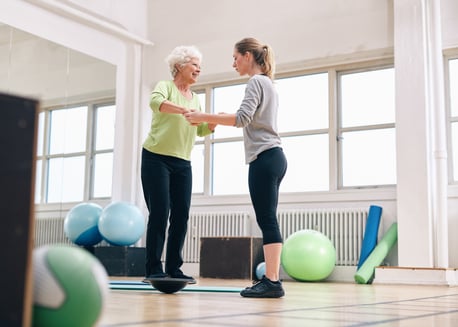 If you’ve ever worked with older adults you likely know about this love/hate relationship everyone has with any program labeled “Fall Prevention”. Residents are certainly interested in learning about how to prevent falls. They have a healthy fear of falling. But often times, they don’t want to move outside of their comfort zone to practice the things that will actually improve balance and fall prevention.
If you’ve ever worked with older adults you likely know about this love/hate relationship everyone has with any program labeled “Fall Prevention”. Residents are certainly interested in learning about how to prevent falls. They have a healthy fear of falling. But often times, they don’t want to move outside of their comfort zone to practice the things that will actually improve balance and fall prevention.
So what better way to face a fear than head on, right?
That’s what NIFS fitness managers did during Fall Prevention Week. With an average of 50 program participants at each site, there was certainly interest in the topic! Here are some tips for the basics of planning a robust Fall Prevention Week:
Get other departments involved
The week may have been okay without any other staff support, but I think you have a better investment from the community and from the residents when other departments get involved. The first department that comes to mind for this topic is Physical Therapy. Many PT departments were happy to work with NIFS staff in bringing presentations, device checks, and even home safety checks to residents. I think it goes without saying that partnering with Food & Beverage is always fun because who doesn’t like to have snacks? Fortunately, many of our communities also have a dietitian on-site and are able to take it one step further with an event centered on balancing nutrition along with balancing the body. The possibilities are really endless.
Have a mix of interactive and educational events
One of the most popular events across the board was the Fall Prevention Presentation with the Getting Up From a Fall Workshop. During this presentation, NIFS staff members discussed ways to avoid falls in the first place, but they also took the time to demonstrate how to safely fall and (where appropriate) how to get back up off the floor. Participants then had the option to work one-on-one with staff and learn how to safely get themselves onto the floor and back up into a chair without falling. Residents appreciated the chance to learn and then to try things themselves.
Follow up with participants
A key element to Fall Prevention Week is tracking who participated so we know who to reach out to afterwards. There’s always a “next step” available so it’s nice to be able to personalize that according to the needs of the specific participant. For some people, it’s a balance evaluation, for others it might be a 1-on-1 exercise prescription, and for others it’s simply going to be a class recommendation. No matter what the recommendation is, just following up with each individual makes the week more personal and gives them more buy-in to continue working on their own fall prevention skills.

